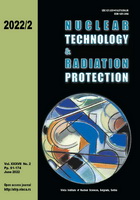
EFFICIENCY OF MARKETABLE DECONTAMINATION AGENT AND GRAPHENE OXIDE ON 99mTc AND 131I SPILLAGES IN NUCLEAR MEDICINE DEPARTMENT
Pages: 159-166
Authors: Mohammad Khairul Azhar Abdul Razab, Norazlina Mat Nawi, Rosidah Sunaiwi, An'amt Mohamed Noor, Mohd Zahri Abdul Aziz, Fara Hana Mohd Hadzuan, Fathirah Ibrahim, Ahmad Thaifur Khaizul, and Nor Hakimin AbdullahAbstract
Dealing with open sources of radioactive substances in nuclear medicine is a daily task since contamination due to radioactive spills may happen frequently. Proper and safe decontamination management is a vital procedure. However, regular purchase of decontamination agents incurs high costs and might be toxic due to their chemical properties. The purpose of this study is to compare graphene oxide, which is an environmentally friendly carbon-based material and marketable decontamination agent, in decontaminating radioactive spillage. Samples of pure 99mTc and 131I from the laboratory were spilled on a petri dish. The spill was immediately decontaminated with a marketable decontamination agent swab and varying concentrations of graphene oxide swab. The initial radioactivity of each swab containing 99mTc and 131I was measured using a dose calibrator. The absorbance spectra of each sample were analysed using an ultraviolet-visible spectrophotometer. The morphology image of graphene oxide was observed under field emission scanning electron microscope. For decontamination using a marketable decontamination agent, the radioactivity of 131I was slightly higher, whereas that of 99mTc was slightly lower than the high concentration of graphene oxide. The absorbance spectra of 99mTc and 131I that had been decontaminated using graphene oxide were observed at a range of 200 nm to 250 nm due to the p ® p* transition.
Key words: nuclear medicine, radioactivity, 131I, 99mTc, graphene oxide, spillage, decontamination
FULL PAPER IN PDF FORMAT (1,07 MB)
